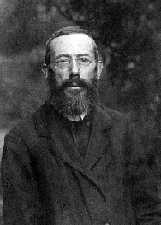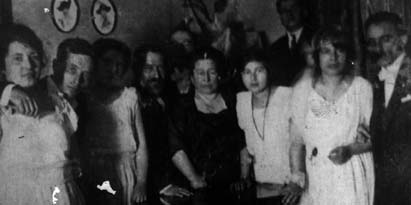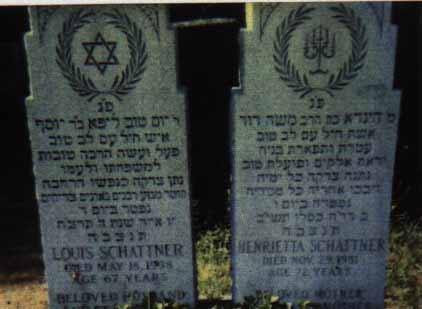Schattner Family Genealogy
 The Schattner family name appears to belong to, at
least, two distinct families. One family - to which I
belong - is Jewish and comes from the town of Kuty (or Kitev
in Yiddish) which is currently part of the Ukraine. Except
when noted otherwise this is the family that I will be referring to
in this website as the "Schattner Family." (The other
Schattner family is located primarily in Germany, Austria and the
Midwest of the United States and is not Jewish. There are
genealogical records for this Schattner family going back to at
least 1665 in Germany. It is interesting to consider whether
the two Schattner families may have been related at some point in
the distant past. However I am aware of no evidence to support
this speculation.)
The Schattner family name appears to belong to, at
least, two distinct families. One family - to which I
belong - is Jewish and comes from the town of Kuty (or Kitev
in Yiddish) which is currently part of the Ukraine. Except
when noted otherwise this is the family that I will be referring to
in this website as the "Schattner Family." (The other
Schattner family is located primarily in Germany, Austria and the
Midwest of the United States and is not Jewish. There are
genealogical records for this Schattner family going back to at
least 1665 in Germany. It is interesting to consider whether
the two Schattner families may have been related at some point in
the distant past. However I am aware of no evidence to support
this speculation.)
Origin of the Schattner Name
Because of the very limited geneological records in Eastern Europe -
especially for Jews - information about the Schattner family prior
to the early 1800's is virtually non-existent. The origin of the
Schattner name is obscure as well. Most members of the family
appear to believe that the name stems from the German word
"Schatten" meaning shadow. However an alternative explanation
in the "Encyclopedia of Jewish Names" suggests that the name
Schattner came from the Polish word "szata" meaning garment.
This interpretation appears plausible especially since several of
the Schattners of the 19th century appear to have been in the
garment business. Yet another claimed origin comes from an old
German genealogical book which claims that the name Schattner comes
from old Lower German word "Schatter" meaning appraiser or money
collector.
Kuty
In the 1800's, essentially all of the Schattners appear to have
lived in the village of Kuty. Kuty is located at the
base of the Carpathian Mountains on the Czermosz River on the border
between the provinces of Bukovina and Galicia. The nearest city of
any size is Czernovtsy. A good map
of this area is available on the Web. (Kuty is in the lower right
corner of the map - it is located approximately 50 km west of
Czernovitz). At various times in the last two centuries,
Kuty has been part of Poland, Austria-Hungary, Roumania, the Soviet
Union and the Ukraine.
Kuty was a small town of approximately 5000 people. In
medieval times, Kuty was for seven years the home of the Jewish
scholar, Baal Shem Tov. At the turn of the twentieth century
approximately half of the population was Jewish. Many left
Kuty during World War I and in the years between the World
Wars. The Jews who remained were killed in the
Holocaust. At present there are essentially no Jews in
Kuty. There are two good books available on Jewish life in
Kuty prior to World War II - "The Kuty
Memorial Book" written after World War II by the survivors
from Kuty in Israel and "Kitov, My Hometown - Survivors of Kuty
Tell the Story of their Hometown" by Chiam Zins.
Unfortunately these books are available only in Yiddish and Hebrew
respectively. More information about Kuty is
also available on the Web. For a more "first-hand"
description, you may be interested to read my journal and see some photos from
my recent travels to the Western Ukraine in search of links to my
Schattner past.
Family History
The most consistent characteristic of the members of the Schattner
family in the 19th and early 20th century appears to be how
religious they were. Nearly every branch of the family
remembers at least one rabbi or scholar among their ancestors.
Some of these scholars achieved considerable respect in the
community. For example,the Kuty Memorial Book contains two
references to the Schattners:
- "Rabbi Chaim Schattner who had a reputation of the best
scholar of Kitev. He mainly tutored privately and later
became principal of Kitev Talmud Torah."
- "Until the beginning of WWI there was an excellent Hebrew
School in Kitev under the supervision of the highly educated
Hebraist Rabbi Yakov Schattner (see photo below). His
students, boys and girls, were among the first who popularized
modern Hebrew literature and created the basis for the next
generation of Jewish youth." (Note: this Yakov Schattner
is the son of Joseph Schattner on page 2 of the Schattner Tree).

Abraham Keusch was a
cousin via marriage of this Yakov (Jacob) Schattner. Keusch
wrote a memoir of his life growing up in Eastern Europe which
contains many references to Joseph and Jacob Schattner and other
members of the Schattner family. The memoir includes many
fascinating anecdotes and descriptions of Jewish life in Galicia /
Bukovina in the late 1800's and early 1900's. Excerpts from a
translation of his memoirs which refer to Schattners is available here.
Around the turn of the century a few members of the family such as
Philip Schattner (page 15 of the
Schattner Charts), Joseph David Schattner (page 8), Joseph Schattner (page 6) and Wolfe Shatner
immigrated to the United States and Canada. Their descendents
form the majority of the Schattner family members in the US and
Canada today. (Wolfe Shatner changed the spelling of his family name
when he arrived in Canada).
Several other branches of the family moved to Vienna at the time
of World War I and lived there until they were forced to flee
during World War II. A page from the 1936 Viennese telephone book shows
the addresses of several of the family members who lived in Vienna
at that time. Other members of the family moved to
Palestine, Shanghai, Australia, Switzerland and South America
during this time period often for the purpose of escaping the
Holocaust. As a result descendents of the Schattner Family
of Kuty can now be found in - at least - 11 countries (US, Canada,
Israel, Venezuela, Argentina, Italy, Australia, Brazil, Singapore,
Peru, England). However scores of other Schattners perished
during the Holocaust in Europe.
Well Known Family Members
Probably the best known member of the Schattner Family is William
Shatner, the noted actor of "Star Trek" fame. As the
grandson of Wolfe Shatner - after whom he was named - William
Shatner shares the atypical family surname spelling common to
members of the Canadian branch.
Within the realm of modern Jewish history, two other important
members of the Schattner family stand out - Berl Loker and
Mordechai Schattner. Berl Loker (page
2 of the family chart) started out as the editor of the
"Yiddisher Arbeiter" (Jewish Worker) Newspaper in Lvov,
Poland. He also was one of the early leaders of the Zionist
Labor Movement. Later he became chairman of the Jewish
Agency. His autobiography - "From Kuti to Jerusalem" - was
published in Israel in 1970 (in Hebrew). In the introduction to his autobiography, Loker
describes interesting anecdotes from his childhood including why
his last name was not Schattner - even though his father was Yakov
Schattner (the Hebrew teacher mentioned in the Kuty Memorial
Book). In addition, Yakov Schattner and Berl Locker's branch
of the family are mentioned in the Memorial book of the village of
Zablatov.
Mordechai Schattner (son of Meschulim Schattner - see page 1 of the Family Chart) was
also a Zionist pioneer who helped in the development of one of the
early kibbutzim in the 1920's. In the late 1930's he
returned to Europe as an emissary from Palestine to try to
persuade Jews to leave Europe for Palestine before it was too
late. Later, he became a close associate of David Ben-Gurion
and was one of the signers of the Israeli Declaration of
Independence. (Apparently Ben-Gurion wanted him to change his
family name to something more "Israeli" - as Ben-Gurion and most
of his other associates had done. But Mordechai Schattner
replied that he didn't want to distance himself from his family
origins - and declined to change his surname.)
Other Interesting Facts
 Wedding of
Laura Schattner (daughter of Hirsch Schattner - page 5) in Buenos Aires, 1922.
Wedding of
Laura Schattner (daughter of Hirsch Schattner - page 5) in Buenos Aires, 1922.
Obviously there are more stories of the Schattners than I have
the space or knowledge to include here. A few "tid-bits"
will need to suffice:
- Family legend spoke of a family ancestor - "Yossele
Ha-Sandler" (Joseph, the Shoemaker) - who besides being a
shoemaker was also widely known medieval Jewish sage.
- Many members of of the Schattner family have been physicians.
One was Robert Schattner who invented the popular oral
antiseptic, Chloraseptic. (Son of Isadore Schattner - page 8). In 1999, Robert
Schattner donated $4 million to create the Robert Schattner
Center at the Dental School of the University of Pennsylvania.
- Yitzhak Schattner was a well known geography scholar and
author in Jerusalem. (Son of Abraham Schattner - page 3)
- A few members of the Schattner family became quite
wealthy. According to a family legend, one of them was a
Mordechai Schattner (not the same Mordechai Schattner who signed
the Israeli Declaration of Independance) who became rich by
seeing a winning lottery number in a dream.
- The Schattner family seems to have been on good terms with the
Schmerler family. Within the last 150 years, there are at
least three examples of a Schattner marrying a Schmerler
(including my grandparents Schulim Schattner and Devora
Schmerler).
- At least one "family history" book of the Schattners was
compiled by Leepa Schattner (Son of Joseph Schattner - page 6), some fifty years
ago. It was apparently deposited in the New York Public
Library. Unfortunately no one can find it anymore!
- The branch of the family descended from Mordechai Schattner
and Devora Stein (which is found on pages 1 to 5 of the charts)
appears to have an even longer illustrious religious heritage.
Devora Stein was the daughter of Rabbi Dovid Stein of Kuty who
is believed to be descended from several other reknowned Jewish
religious leaders including Rabbi David Halevi (1586-1667) known as "the Taz".
 Tombstones of Leepa and Henrietta Schattner.
Tombstones of Leepa and Henrietta Schattner.
The Charts
The Schattner Family Charts are an attempt to give an indication of
the size and movement of the Schattner family over the last 150
years. I make no claim as to the accuracy - and certainly not
to the completeness - of the information. Information
generally came from oral recollections of family elders. I
believe I have recorded their recollections faithfully - but
memories can dim over the years.
Because there are so many people involved the charts can be a
little hard to follow. Also many of the same names keep
recurring - e.g. Mordechai and Joseph. The problem is
compounded by the fact that in many cases, links between family
branches are speculative or completely unkown.
One way to follow the charts is to start with the "19th Century Family Outline", to
find the name of the ancestor of the branch of interest, and then
to track "back to the future" to find the branch of the tree which
is of interest.
More Information
For more information on Jewish genealogy, an excellent place to look
is the Jewish Genealogy
Website. Malkie Griffel has compiled the information on the
Mordechai Schattner - Devora Stein branch of the family into two
genealogical books. For more information or to purchase these books,
contact her at barmag@netvision.net.il.
Feedback and Acknowledgements
My intention is to maintain and improve this site over time. I
could use some help - if any of you have any old and/or interesting
photographs that you think might be appropriate for inclusion in
this site please let me know. Similarly if you have any other
relevant family information, I'd be glad to hear about
it. Many people have already helped me greatly in
gathering the Schattner Family information found on this
website - especially Jehuda Schattner, Ruth Switzer, Margarita
Blei and Malkie Griffel - thank you so much! Or even if you
just have feedback on the interest and usability of the information
here, I'd enjoy receiving e-mail at
schattnerATalumDOTswarthmoreDOTedu (just replace the "AT" with "@"
and the "DOT"s with "."s). Thanks.
Return to Peter Schattner's Personal Home Page.
This page last updated on
12/01/09

 Wedding of
Laura Schattner (daughter of Hirsch Schattner - page 5) in Buenos Aires, 1922.
Wedding of
Laura Schattner (daughter of Hirsch Schattner - page 5) in Buenos Aires, 1922.
 Tombstones of Leepa and Henrietta Schattner.
Tombstones of Leepa and Henrietta Schattner.